- A scientist is using the Hardy-Weinberg equation to assess if a population is in equilibrium or is evolving. She recorded the following characteristics for this population:
A. The size of the population is very large.
B. Individuals are randomly mating.
C. Individuals are under natural selection.
D. New alleles are added to the population through migration and dispersal.
E. Mutation rates are high.
Which one of the following options contains all INCORRECT characteristics of a population in Hardy- Weinberg equilibrium?
(1) A and D (2) C, D and E
(3) A, B and C (4) B and EWhich Characteristics Are Incorrect for Hardy-Weinberg Equilibrium? Understanding Population Genetics Assumptions
The Hardy-Weinberg principle is a foundational concept in population genetics, offering a model for predicting how allele and genotype frequencies remain constant from generation to generation—but only if certain conditions are met. If these conditions are violated, the population is not in Hardy-Weinberg equilibrium and is likely evolving.
The Five Key Assumptions of Hardy-Weinberg Equilibrium
To maintain genetic equilibrium, a population must meet these criteria:
-
Random mating: Individuals pair by chance, not by genotype or phenotype.
-
No mutation: No new alleles are introduced into the gene pool.
-
No natural selection: All genotypes have equal fitness.
-
No migration (gene flow): No new alleles are added or lost through movement of individuals.
-
Very large population size: Prevents random changes in allele frequencies (genetic drift).
Analyzing the Population Characteristics
Let’s review the characteristics provided:
-
A. The size of the population is very large.
This is a correct assumption for Hardy-Weinberg equilibrium. -
B. Individuals are randomly mating.
This is also a correct assumption for Hardy-Weinberg equilibrium. -
C. Individuals are under natural selection.
This is incorrect: Natural selection changes allele frequencies and disrupts equilibrium. -
D. New alleles are added to the population through migration and dispersal.
This is incorrect: Migration (gene flow) introduces new alleles, violating equilibrium. -
E. Mutation rates are high.
This is incorrect: High mutation rates introduce new alleles, disrupting equilibrium.
Which Options Are INCORRECT for Hardy-Weinberg Equilibrium?
The characteristics that do not fit the Hardy-Weinberg assumptions are:
-
C. Individuals are under natural selection
-
D. New alleles are added to the population through migration and dispersal
-
E. Mutation rates are high
Correct Option
From the provided choices:
-
(1) A and D
-
(2) C, D and E
-
(3) A, B and C
-
(4) B and E
The correct answer is (2) C, D and E.
Conclusion
Natural selection, migration, and high mutation rates are all incorrect characteristics for a population in Hardy-Weinberg equilibrium, as they disrupt genetic stability and cause allele frequencies to change over generations
-



